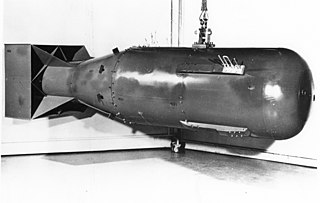 W
WNuclear weapons tests are experiments carried out to determine the effectiveness, yield, and explosive capability of nuclear weapons. Testing nuclear weapons offers practical information about how the weapons function, as well as how detonations are affected by different conditions; and how personnel, structures, and equipment are affected when subjected to nuclear explosions. However, nuclear testing has often been used as an indicator of scientific and military strength, and many tests have been overtly political in their intention; most nuclear weapons states publicly declared their nuclear status by means of a nuclear test.
 W
WNuclear weapons testing is the act of experimentally and deliberately firing one or more nuclear devices in a controlled manner pursuant to a military, scientific or technological goal. This has been done on test sites on land or waters owned, controlled or leased from the owners by one of the eight nuclear nations: the United States, the Soviet Union, the United Kingdom, France, China, India, Pakistan and North Korea, or has been done on or over ocean sites far from territorial waters. There have been 2,121 tests done since the first in July 1945, involving 2,476 nuclear devices. As of 1993, worldwide, 520 atmospheric nuclear explosions have been conducted with a total yield of 545 megaton (Mt): 217 Mt from pure fission and 328 Mt from bombs using fusion, while the estimated number of underground nuclear tests conducted in the period from 1957 to 1992 is 1,352 explosions with a total yield of 90 Mt.
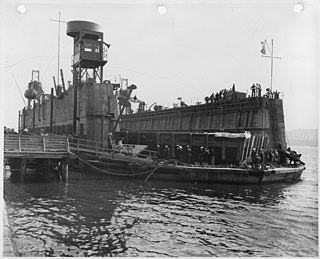 W
WThe ARDC-13 was a 2800-ton auxiliary floating drydock used for testing during the Able and Baker nuclear weapon tests of Operation Crossroads in the Bikini Atoll. It was used to determine the effects of the atomic bomb phenomena on land-based concrete structures. The final report on ARDC-13 was part of a final supplementary report to the Commander Joint Task Force One. The ARDC-13 was built by the Haddock Company out of Pasadena, California in March 1946 under contract Noy-11999. It was 84 feet by 389 feet with a depth of 14 feet. Two wingwalls, both 26 feet high and 306 feet long, were mounted on top of the ARDC-13. Steel frames were built within the wingwalls for extra support. The wingwalls consisted of transverse frames and both water and non-watertight bulkheads. The ARDC-13 was important for confirming that water-front structures needed to be designed to withstand severe waves and flooding as ports are considered a good target for bombs.
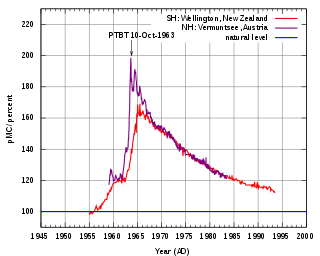 W
WThe bomb pulse is the sudden increase of carbon-14 (14C) in the Earth's atmosphere due to the hundreds of aboveground nuclear bombs tests that started in 1945 and intensified after 1950 until 1963, when the Limited Test Ban Treaty was signed by the United States, the Soviet Union and the United Kingdom. These hundreds of blasts were followed by a doubling of the relative concentration of 14C in the atmosphere. We discuss “relative concentration”, because measurements of 14C levels by mass spectrometers are most accurately made by comparison to another carbon isotope, often the common isotope 12C. Isotope abundance ratios are not only more easily measured, they are what 14C carbon daters want, since it is the fraction of carbon in a sample that is 14C, not the absolute concentration, that is of interest in dating measurements. The figure shows how the fraction of carbon in the atmosphere that is 14C, of order only a part per trillion, has changed over the past several decades following the bomb tests. Because 12C concentration has increased by about 30% over the past fifty years, the fact that “pMC”, measuring the isotope ratio, has returned (almost) to its 1955 value, means that 14C concentration in the atmosphere remains some 30% higher than it once was. Carbon-14, the radioisotope of carbon, is naturally developed in trace amounts in the atmosphere and it can be detected in all living organisms. Carbon of all types is continually used to form the molecules of the cells of organisms. Doubling of the concentration of 14C in the atmosphere is reflected in the tissues and cells of all organisms that lived around the period of nuclear testing. This property has many applications in the fields of biology and forensics.
 W
WA bomb tower is a lightly constructed tower, often 100 to 700 feet high, built to hold a nuclear weapon for an above ground nuclear test. The tower holds the bomb for the purpose of the investigation of its destructive effects and for the adjustment of measuring instruments, such as high-speed cameras. Normally, the bomb tower disintegrates completely on detonation due to the enormous heat of the explosion.
 W
WThe Comprehensive Nuclear-Test-Ban Treaty (CTBT) is a multilateral treaty that bans all nuclear tests, for both civilian and military purposes, in all environments. It was adopted by the United Nations General Assembly on 10 September 1996, but has not entered into force, as eight specific nations have not ratified the treaty.
 W
WDaigo Fukuryū Maru was a Japanese tuna fishing boat with a crew of 23 men which was contaminated by nuclear fallout from the United States Castle Bravo thermonuclear weapon test at Bikini Atoll on March 1, 1954.
 W
WA fizzle occurs when the detonation of a device for creating a nuclear explosion grossly fails to meet its expected yield. The cause(s) for the failure can be linked to improper design, poor construction, or lack of expertise. All countries that have had a nuclear weapons testing program have experienced some fizzles. A fizzle can spread radioactive material throughout the surrounding area, involve a partial fission reaction of the fissile material, or both. For practical purposes, a fizzle can still have considerable explosive yield when compared to conventional weapons.
 W
WWhen the Limited Test Ban Treaty came into effect in 1963, nuclear testing in the atmosphere was prohibited. However alternatives to atmospheric nuclear testing were required to continue the study of nuclear weapons effects. These would allow obtaining data related to air-blast, ground-shock, structure-response data, bio-medical effects and other various phenomena. Large scale field tests using conventional high explosives were devised to this end. The following is a list of such events with yields of more than 1000 pounds.
 W
WThe International Day against Nuclear Tests is observed on August 29. It was established on December 2, 2009 at the 64th session of the United Nations General Assembly by the resolution 64/35, which was adopted unanimously.
 W
WThe Partial Test Ban Treaty (PTBT) is the abbreviated name of the 1963 Treaty Banning Nuclear Weapon Tests in the Atmosphere, in Outer Space and Under Water, which prohibited all test detonations of nuclear weapons except for those conducted underground. It is also abbreviated as the Limited Test Ban Treaty (LTBT) and Nuclear Test Ban Treaty (NTBT), though the latter may also refer to the Comprehensive Nuclear-Test-Ban Treaty (CTBT), which succeeded the PTBT for ratifying parties.
 W
WRope trick is the term given by physicist John Malik to the curious lines and spikes which emanate from the fireball of certain nuclear explosions just after detonation.
 W
WSeverny Island is a Russian Arctic island. It is the northern island of the Novaya Zemlya archipelago. It was historically called Lütke Land after Friedrich Benjamin von Lütke who explored it. It lies approximately 400 km north of the Russian mainland. It has an area of 48,904 square kilometres (18,882 sq mi), making it the 30th-largest island in the world. It is part of Russian Arctic National Park.
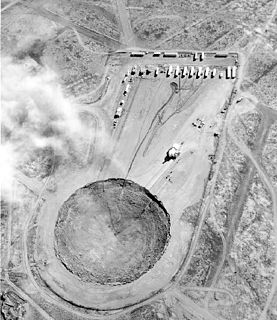 W
WA subsidence crater is a hole or depression left on the surface of an area which has had an underground explosion. Many such craters are present at the Nevada Test Site, which is no longer in use for nuclear testing.
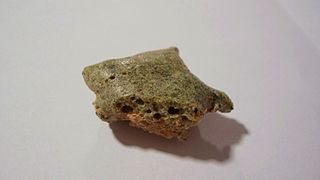 W
WTrinitite, also known as atomsite or Alamogordo glass, is the glassy residue left on the desert floor after the plutonium-based Trinity nuclear bomb test on July 16, 1945, near Alamogordo, New Mexico. The glass is primarily composed of arkosic sand composed of quartz grains and feldspar that was melted by the atomic blast. It was first academically described in American Mineralogist in 1948.
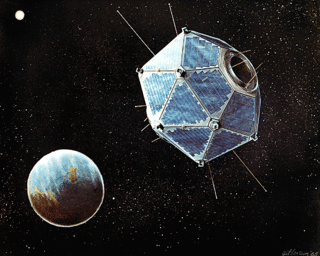 W
WVela was the name of a group of satellites developed as the Vela Hotel element of Project Vela by the United States to detect nuclear detonations to monitor compliance with the 1963 Partial Test Ban Treaty by the Soviet Union.